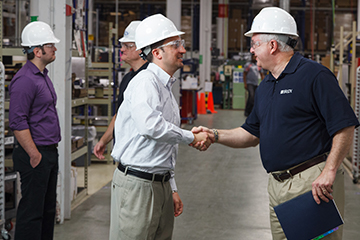Managing Change in the Workplace
Change – it’s happening
If it feels like the world is constantly changing, you're right.
Bigger events see bigger changes – in the workplace, with families, in supply chains and with productivity. And this isn’t just during times of crisis, like a pandemic. Change also comes with mergers, implementing new safety programs and even adding new products in the marketplace.
When approaching the subject of change, it’s fair to say very few things remain as they are, without ever changing. So, with change happening all the time, why is dealing with change one of the most difficult problems organizations face today?
Since change – and the way it’s managed – affects employees at every level, in every industry, it merits a closer look. By breaking it down and examining its components, we can begin to understand it better. This includes defining what change management is, outlining the process, troubleshooting obstacles to the process and finding the best practices to make it work.
So, what is change management?
Tracing the roots of change management is not easy. This is because the concept comes from many different disciplines. Though economics and business administration naturally play a part, so do sociology, anthropology, psychology and even engineering.
When defining it, some point to outside forces driving the need for change. In a telecommunications industry study, one researcher defines change management as, “when the organization decides to alter the present mode of business activities into a new one style or model to cope with rapid changes of the business world, but keeps in mind the profit maximization factor.”[1]
Others, like Lorenzi & Riley, who researched information systems in health care organizations, place an emphasis on how it happens. “Change management is the process by which an organization gets to its future state, its vision.”[2] This implies that change is not an event, but rather a process.
If we combine these two definitions, we get a model that looks like this:
This model begins and ends with normalized states. Everything in between, however, belongs to change management. So, in its most simple form, we can think of change management as a guided process of transition from one state to another.
But, how do we move to a new state to achieve change? This is a great question. But it has no exact answer. Since scientists can’t agree on the best process for change, we can instead look at examples that showed success in managing it in the workplace.
Why do we need it?
Whether you are a machine operator, manager, safety engineer or senior level executive, change management plays a big role in your work experiences. It can contribute to growth, keep workers safe and allow businesses to survive and stay competitive.
Change management can also carry organizations through times of uncertainty and challenging circumstances. When a global crisis hits or a new information system is adopted, this is the piece that should remain steady. Think of it as an organization’s foundation. Businesses rely upon it, and build and sustain their reputation because of it. In short, change management can be seen as the force that provides stability whether there is smooth sailing, or choppy waters.
Why change is difficult … sometimes
If you’ve ever been tasked with increasing worker safety, updating technology, adjusting to amended government policies, or expanding product lines, you’ll need to guide these changes. And how you handle it can make a big difference. Consider the following quote:
"It's not the progress I mind, it's the change I don't like."
—Mark Twain
It appears that while the end result is well received, the road to get there can be suspect. And, while this quote may seem funny, many people agree with it. This is because there is uncertainty that often accompanies change. And with uncertainty, comes resistance to change.
In fields that experience frequent changes, like information technology, there is a constant need for people to adapt. But how do people deal with all that change? An author who studied change in this field had this observation: “Change creates a sense of uncertainty, stress, and anxiety for employees, which is often interpreted as resistance.” This is fear of the unknown. And people who appear to resist change do so because they feel it could be stressful and not as clear-cut as they would like it to be.
But what happens with resistance during a planned initiative like the implementation of a Lean Production System? Initiating a system like LPS takes considerable coordinated effort – from everyone. There are many new processes: Total Quality Management, Total Preventive Maintenance and Just-in-Time, to name a few.
In a 2016 study, researchers looking at this type of system concluded, “the extent of resistance during change depends on the characteristics of the change process.” They then give us those key characteristics, “resistance can be reduced if organizations manage information flow, create room for participation and develop trust in management.”
So, how we address change seems to be as important as the change itself. By providing the right type of support, it’s suggested that employers can decrease resistance, which then can lead to success in achieving their organization’s goals.

Best practices
As mentioned earlier, scientists can’t agree on the exact process for change. There is no single, correct, one-size-fits-all model. In fact, there are countless models for managing the change process. Some are tailored to responding to a crisis, others cater to management and, there are even those that center around the experience of employees.
This doesn’t imply that the majority of models don’t work. Rather, it shows that there are many ways that change can be managed. The silver lining here is that you can make a unique model to fit the exact needs of your organization.
What scientists can agree upon, loosely, is that there are certain components to change management. And, when you implement them, you may have more success in realizing your goals.
-
1. Meet the twins: Leadership and Trust
"Staying true to the purpose, values, principles and culture of an organization starts at the top."
—World Economic ForumWhen a crisis hits, when a new system needs implementing and when markets behave irrationally – these can be seen as moments that define leadership. Employees look to leaders and expect them to provide the bridge to a better future.
If leaders have a clear way forward, human beings are amazingly resilient. There is a documented "rally effect" writes Jim Harter, Ph.D., in a recent Gallup article on leadership and the COVID-19 crisis. But this clear way forward must be paired with something else: trust.
Trust in leadership – and knowing that your leaders will guide everyone effectively – is a BIG component of change management. It can weather the storms and lead everyone to a brighter future. “Effective leaders are transparent, empathetic and create trust, and their behaviors help calm, support and even energize employees so that they feel vested in a common mission and purpose, and embrace new ways of working.”
But this type of trust isn’t just blind faith. “Trust is built through dialogue and actions, not proclamations and intentions.” So, it becomes clear that the first steps begin with both trust and a solid game plan.

-

2. Start with a clear plan
"While an initial crisis may not have been preventable, the secondary crisis of a bungled response is avoidable."
— Jim McNulty, Leading Through COVID-19, Finding hope and opportunity in a global calamity
To begin the process of change management, a clear plan is needed – and the simpler, the better. This should focus on the “what” you are trying to accomplish. If this is absent, the change may stagnate or, worse yet, fail to materialize.
Instead of being vague (a trap that’s easy to fall into), define the change you intend to make. This includes laying it out: how it can be achieved, how it can be monitored, what risks there are, and how its success can be measured. By using a consistent strategy for the entire organization, you can unify the organization – and move closer to achieving your goal.
But you can’t just roll the plan out and expect it to magically happen. For that, you’ll need to rely on a team structure. And this usually starts with upper management. It’s important that they both (A) understand the goal, and (B) are unified in their approach for making change. If not, they may take it in a different direction, which can affect its overall success.
Next, once the team leaders are on board, it’s time to do the same for every other employee. This process relies on frequent communication for both managers and workers they supervise.
-
3. Communicate by keeping it simple
Though people often profess they can multitask, the human brain can only work with a few concepts at a time. Therefore, it’s best to simplify communication. By giving employees a comprehensive overview of all the steps in one sitting, you may think you’re being transparent. But, you’ll probably overwhelm them. Instead, streamline your message to 3–5 points. And, keep the language simple so it’s easy to understand.
- By communicating a clear vision, people start to understand the logic behind the change. This can be accomplished ahead of time with educational pieces that include presentations and group discussions. Or, it can be done in the moment with emails, social media posts, posters and handouts.
- In the case of COVID-19 pandemic, many businesses created FAQ guides, and made available links to official recommendations of external organizations such as the Centers for Disease Control and Prevention (CDC), The World Health Organization (WHO), Johns Hopkins University, local governments and outbreak maps. When a crisis hits, information is usually updated frequently, so your communications should be too.
The best way to communicate is how your organization usually conveys information. When people are already familiar with the process, your message may resonate better. A message that is simple, accessible and conveyed effectively is essential for this type of communication.

-
4. Keep the culture
In developing support for a change, it’s important to keep in mind your organization’s history. In doing so, you can build upon it with the current challenge, and use it to propel the new vision into the future.
Because the change process is uncertain, supporting it with a message of continuity is important. As counterintuitive as this sounds, what you’re really doing is preserving the essence of the organization when uncertainty looms on the horizon. Who you are is your culture, and you don’t want to change that. And wide-scale changes might threaten that. So, find a way to align existing routines with your new practices and fit them into everyone’s day-to-day work experience.
-
5. Invite participation
When supporting change in the workplace, it may happen that, despite all your efforts, your intended change is not embraced. This can take the form of a speed bump or a roadblock, depending on how it’s handled. Since the status quo is often easiest, asking people to change can be difficult. Typically, most people only accept changes that can improve their work experience. So, asking them to learn new information, adopt new behaviors and perform new processes may be a challenge.
But, there may be a way around this: with participation. Research shows that participation generally leads to commitment, which can be a buoyant force in change acceptance. The good news here is that there are countless ways in which employees can get involved – and on board with – the intended change. For this, think large groups and one on ones, inter-group events, surveys and feedback activities, consultations and team-building activities.
-
6. Use a mirror—monitor and adjust
Before we leave for work each morning, many of us take a look in the mirror. This provides a quick check and we can make a change if we need to. Change management works this way too.
It’s easy to get caught up in the day-to-day activities that support change. But, what about the big picture? Building in checks along the way to monitor progress is a sound practice. It can show if you’re inching toward the finish line or losing ground. This typically is done by gathering metrics, either with formal or informal checks. That way, you can adjust your process in order to improve performance and get closer to your realized goal.
If progress is not monitored and there is no room for flexibility while you’re managing change, the goal could start to fade away. Adjustments made during a change process are, in fact, a natural occurrence and shouldn’t be viewed as if something went wrong. This is why records during a time of change are often called living documents.
Think about the responses to a rapidly changing crisis like COVID-19. In light of newer information, older documents got obsoleted. Guidelines expired and different recommendations were offered. Managing change as it’s evolving is tricky business. It requires flexibility and willingness to admit that the situation is changing. You’ll need to communicate this, and clearly, so everyone can continue moving as one in the right direction.

Making it work
How change is handled can forecast the weather that’s coming. Not 100%, but perhaps closer than you imagined. It can save your organization from freefall and make it more stable – even though changing at the same time.
Change management is not a quick fix. It’s a process. And, whether it’s a worldwide event or you’re updating processes, change can be managed when it’s supported by using a handful of best practices. And, after change is complete and you arrive at a new status quo, reflect back on your plan. Did it work? Did it work well? How could it have worked better?
To troubleshoot for future changes, look beyond your organization’s experiences. Recent COVID-19 responses, which pushed change management to its limits, can provide a wealth of examples from which we can learn. Experiences during this time won’t be forgotten soon – nor should they. And neither should its lessons. To keep asking questions about how change is managed is how we become more effective. And it’s how we can best prepare for the future.
Brady Corporation has a long history of providing businesses the tools they need to manage change. Their safety and identification solutions are designed for challenging situations like the COVID-19 pandemic, working with standards and regulations, creating visual workplaces and even implementing Lean Management Systems. So, if you’re rethinking your safety program, give Brady a call. They can help you achieve your goals – safely – so your organization can keep moving forward.

References
- Hashim, M. (2013). "Change Management"(opens in a new tab) . International Journal of Academic Research in Business and Social Sciences, 3(7), 685-694.
- Lorenzi, N. M., & Riley, R. T. (2000). "Managing change: an overview"(opens in a new tab) . Journal of the American Medical Informatics Association: JAMIA, 7(2), 116–124.
- Slattery, J. (2013). "Change Management"(opens in a new tab) . Journal of Strategic Leadership, 4(2), 1-5.
- Radzi, N. & Othman, R. (2016). Resistance to Change: The Moderating Effects of Leader-Member Exchange and Role Breadth Self-Efficacy. Journal of Advanced Management Science, 4(1), 72-76.
- Harter, J. (2020, March 23). "COVID-19: What employees need from leadership right now"(opens in a new tab) . Gallup.
- World Economic Forum. (2020). "Workforce Principles for the COVID-19 Pandemic – Stakeholder Capitalism in a Time of Crisis"(PDF opens in a new tab) . White paper.
- McNulty, E. J. (2020, March 6). "Leading through COVID-19, finding hope and opportunity in a global calamity"(opens in a new tab) . MIT Sloan Management Review.
- Emond, L. & Maese, E. (2020, March 15). "COVID-19 strategies and policies of the world’s largest companies"(opens in a new tab) . Gallup.
Further Reading
- de la Sablonnière, R. (2017). "Toward a Psychology of Social Change: A Typology of Social Change" (opens in a new tab). Frontiers in Psychology, 8 (3), 1-20.
- Reeves, M., Lang, N. & Carrolson-Szlezak, P. (2020, February 27). "Lead your business through the coronavirus crisis" (opens in a new tab). Harvard Business Review.
- Stouten, J., Rousseau, D. & Cremer, D. (2018). "Successful Organizational Change: Integrating the Management Practice and Scholarly Literatures" (opens in a new tab). Academy of Management Annals.
- Venus, M., Stam, D. & van Knippenberg, D. (2018). "To get people to embrace change, emphasize what will stay the same" (opens in a new tab). Harvard Business Review.
